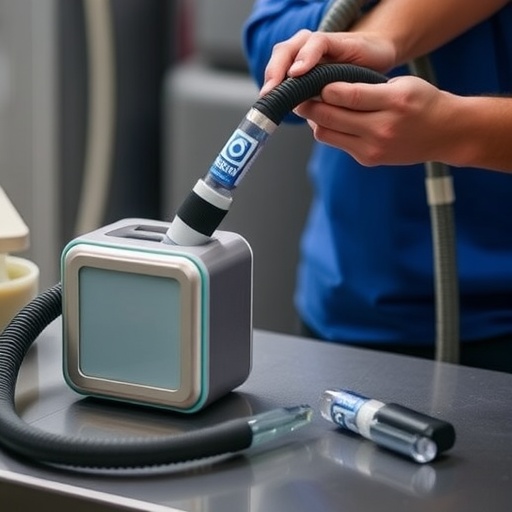
In an era where healthcare innovations emerge at an unprecedented pace, one of the critical, yet often overlooked, components of clinical efficacy is the assessment of devices used in patient care. A groundbreaking study published in the Annals of Biomedical Engineering delves into the performance evaluation of portable suction devices, shedding light on a vital yet underappreciated parameter: the time-averaged air flow rate.
Portable suction devices play a crucial role in various medical procedures, including emergency care and surgical operations. These devices are fundamental in managing secretions and maintaining clear airways, particularly in patients with compromised respiratory functions. Despite their significance, the methodology for assessing their performance has remained stagnant over the years, relying on outdated standards that fail to provide a comprehensive evaluation of their efficiency and capability in real-world scenarios.
The authors of this pivotal study—led by prominent figures S.R. Peri and F. Akhter, along with R.A. De Lorenzo—recognize the urgent need for a revised standard that can accurately reflect the operational abilities of portable suction devices. Current methods primarily focus on peak suction performance rather than a sustained, functional flow rate, which is more relevant during actual patient management situations. The research emphasizes that time-averaged air flow rate serves as an essential metric because it better simulates the prolonged operational demands faced by healthcare professionals in high-stress environments.
During the investigation, the researchers meticulously designed a set of experiments that tested various models of portable suction devices under simulated clinical conditions. By employing sophisticated measurement techniques, they were able to capture real-time data on air flow rates, not just during the peak moments, but across the entire usage spectrum. This method yielded a more accurate representation of each device’s capabilities, thereby providing invaluable insights into their practicality and reliability in actual healthcare settings.
Central to their findings is the influence of design and engineering on the time-averaged air flow rate. The study reveals that various factors—including the device’s motor specifications, suction tip design, and reservoir capacity—significantly impact performance metrics. The results suggest that manufacturers who prioritize these design aspects are more likely to produce devices that not only meet, but exceed the expectations set by current standards.
Interestingly, the research also touches upon the implications of these findings on patient outcomes. Devices that demonstrate higher time-averaged air flow rates tend to perform better in real-world applications. Consequently, they contribute to improved management of patients’ respiratory needs, ultimately leading to enhanced recovery times and reduced complications. This notion amplifies the study’s impact, as it links engineering standards directly to patient care and clinical efficacy.
Furthermore, the authors argue for the standardization of testing protocols across the industry. Inconsistent methodologies can lead to misleading performance claims and confuse healthcare providers when selecting appropriate suction devices for their clinical needs. The study advocates for a unified approach, suggesting that regulatory bodies should consider adopting time-averaged air flow rate as a definitive measurement standard in assessing portable suction devices.
The healthcare industry is continually evolving towards evidence-based practices, and the insights garnered from this research could catalyze a significant shift in how suction devices are evaluated and marketed. As healthcare systems grapple with high-stakes decision-making, the study underscores the need for accurate data that can guide clinical practices and ultimately enhance patient care.
Moreover, this innovative approach to performance evaluation not only benefits clinicians but also empowers patients. With clearer guidelines and more reliable devices, patients can be assured of receiving care that aligns with the highest standards of safety and efficacy. This research connects engineering with direct patient impact, bridging the gap between device manufacturers and healthcare providers.
As the study progresses toward publication, the potential for widespread change in medical device evaluation practices is palpable. The recommendations put forth by the authors may encourage further research, prompting additional studies to explore the efficacy of portable suction devices across diverse medical scenarios. With each advancement in the field, the overarching goal remains clear: to foster technologies that support healthcare professionals and uphold patient care standards.
In conclusion, the findings presented in this study herald a new era in the assessment of portable suction devices. By advocating for a focus on time-averaged air flow rates, the authors pave the way for more reliable measurement standards, ensuring that healthcare practitioners are equipped with effective tools for providing optimal care. As this research gains the attention of the biomedical community, it is poised to instigate a paradigm shift that could redefine industry practices and ultimately lead to better patient outcomes.
Subject of Research: Portable suction devices and their performance assessment.
Article Title: A Better Standard to Assess the Performance of Portable Suction Devices: Time-Averaged Air Flow Rate.
Article References:
Peri, S.R., Akhter, F., De Lorenzo, R.A. et al. A Better Standard to Assess the Performance of Portable Suction Devices: Time-Averaged Air Flow Rate.
Ann Biomed Eng (2025). https://doi.org/10.1007/s10439-025-03764-5
Image Credits: AI Generated
DOI:
Keywords: Portable suction devices, Time-averaged air flow rate, Performance assessment, Clinical effectiveness, Biomedical engineering.
Tags: assessing suction device efficiencybiomedical engineering advancementsclinical efficacy in patient careemergency medical deviceshealthcare device assessmentInnovative healthcare technologiesportable medical equipmentportable suction device performancerespiratory function managementstandards for medical devicessurgical suction devices evaluationtime-averaged air flow rate




